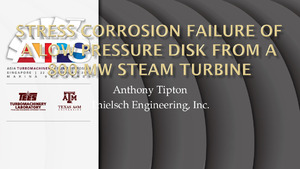| dc.contributor | Asia Turbomachinery & Pump Symposium (1st : 2016) | |
| dc.creator | Tipton, Anthony | |
| dc.date.accessioned | 2017-05-04T12:49:04Z | |
| dc.date.available | 2017-05-04T12:49:04Z | |
| dc.date.issued | 2016 | |
| dc.identifier.uri | https://hdl.handle.net/1969.1/160234 | |
| dc.description | Case Study | en |
| dc.description.abstract | Case Study 1: Stress corrosion cracking is known to be a function of stress, material and environment. However, a fourth variable that is often overlooked is operating time. Maintaining steam chemistry within OEM and industry guidelines is not sufficient to prevent stress corrosion cracking in high stress locations such as the blade attachments of older low pressure turbine disks. Resulting stress corrosion failures occur without warning and generally result in significant secondary damage and unit downtime. Non-destructive examination has been used to identify stress corrosion cracking however, many blade attachment designs are not conducive to inspection without complete removal of blading. This case study discusses the root cause analysis of a recent stress corrosion failure of a low pressure disk from a 800 MW steam turbine. Turbine disk modifications to prevent future stress corrosion cracking are detailed. | en |
| dc.format.medium | Electronic | en |
| dc.format.mimetype | application/pdf | |
| dc.language | en | |
| dc.publisher | Turbomachinery Laboratories, Texas A&M Engineering Experiment Station | |
| dc.relation.ispartof | Asia Turbomachinery & Pump Symposium. 2016 Proceedings. | en |
| dc.subject.lcsh | Turbomachines | en |
| dc.subject.lcsh | Pumping machinery | en |
| dc.title | Stress Corrosion Failure of a Low Pressure Disk from a 800MW Steam Turbine | en |
| dc.type.material | Text | en |
| dc.identifier.doi | https://doi.org/10.21423/R19D6G | |


